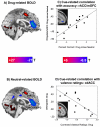Role of the anterior cingulate and medial orbitofrontal cortex in processing drug cues in cocaine addiction
- PMID: 17197102
- PMCID: PMC1852512
- DOI: 10.1016/j.neuroscience.2006.11.024
Role of the anterior cingulate and medial orbitofrontal cortex in processing drug cues in cocaine addiction
Abstract
Our goal in the current report was to design a new functional magnetic resonance imaging (fMRI) task to probe the role of the anterior cingulate cortex (ACC) and orbitofrontal cortex (OFC) in processing of salient symptom-related cues during the simultaneous performance of an unrelated task in drug-addicted persons. We used a novel fMRI color-word drug Stroop task in 14 individuals with cocaine use disorders; subjects had to press for color of drug vs. matched neutral words. Although there were no accuracy or speed differences between the drug and neutral conditions in the current sample of subjects, drug words were more negatively valenced than the matched neutral words. Further, consistent with prior reports in individuals with other psychopathologies using different Stroop fMRI paradigms, our more classical color-word Stroop design revealed bilateral activations in the caudal-dorsal anterior cingulate cortex (cdACC) and hypoactivations in the rostro-ventral anterior cingulate cortex/medial orbitofrontal cortex (rACC/mOFC). A trend for larger rACC/mOFC hypoactivations to the drug than neutral words did not survive whole-brain corrections. Nevertheless, correlation analyses indicated that (1) the more the cdACC drug-related activation, the more negative the valence attributed to the drug words (r=-0.86, P<0.0001) but not neutral words; and (2) the more the rACC/mOFC hypoactivation to drug minus neutral words, the more the errors committed specifically to the drug minus neutral words (r=0.85, P<0.0001). Taken together, results suggest that this newly developed drug Stroop fMRI task may be a sensitive biobehavioral assay of the functions recruited for the regulation of responses to salient symptom-related stimuli in drug-addicted individuals.
Figures

Similar articles
-
Anterior cingulate cortex hypoactivations to an emotionally salient task in cocaine addiction.Proc Natl Acad Sci U S A. 2009 Jun 9;106(23):9453-8. doi: 10.1073/pnas.0900491106. Epub 2009 May 28. Proc Natl Acad Sci U S A. 2009. PMID: 19478067 Free PMC article.
-
Oral methylphenidate normalizes cingulate activity in cocaine addiction during a salient cognitive task.Proc Natl Acad Sci U S A. 2010 Sep 21;107(38):16667-72. doi: 10.1073/pnas.1011455107. Epub 2010 Sep 7. Proc Natl Acad Sci U S A. 2010. PMID: 20823246 Free PMC article.
-
Altered neural response of the appetitive emotional system in cocaine addiction: an fMRI Study.Addict Biol. 2010 Oct;15(4):504-16. doi: 10.1111/j.1369-1600.2010.00230.x. Addict Biol. 2010. PMID: 20579005
-
An fMRI study of Stroop word-color interference: evidence for cingulate subregions subserving multiple distributed attentional systems.Biol Psychiatry. 1999 May 15;45(10):1237-58. doi: 10.1016/s0006-3223(99)00056-6. Biol Psychiatry. 1999. PMID: 10349031 Review.
-
Control of language use: cognitive modeling of the hemodynamics of Stroop task performance.Brain Res Cogn Brain Res. 2002 Dec;15(1):85-97. doi: 10.1016/s0926-6410(02)00218-5. Brain Res Cogn Brain Res. 2002. PMID: 12433384 Review.
Cited by
-
Impact of medial orbital cortex and medial subthalamic nucleus inactivation, individually and together, on the maintenance of cocaine self-administration behavior in rats.Behav Brain Res. 2013 Feb 1;238:1-9. doi: 10.1016/j.bbr.2012.10.021. Epub 2012 Oct 22. Behav Brain Res. 2013. PMID: 23098798 Free PMC article.
-
A serotonergic biobehavioral signature differentiates cocaine use disorder participants administered mirtazapine.Transl Psychiatry. 2022 May 6;12(1):187. doi: 10.1038/s41398-022-01934-w. Transl Psychiatry. 2022. PMID: 35523779 Free PMC article.
-
Functional brain networks associated with cognitive control, cocaine dependence, and treatment outcome.Psychol Addict Behav. 2013 Jun;27(2):477-88. doi: 10.1037/a0029092. Epub 2012 Jul 9. Psychol Addict Behav. 2013. PMID: 22775772 Free PMC article.
-
Cingulo-hippocampal effective connectivity positively correlates with drug-cue attentional bias in opioid use disorder.Psychiatry Res Neuroimaging. 2019 Dec 30;294:110977. doi: 10.1016/j.pscychresns.2019.08.005. Epub 2019 Aug 13. Psychiatry Res Neuroimaging. 2019. PMID: 31439409 Free PMC article.
-
Drug fluency: a potential marker for cocaine use disorders.Drug Alcohol Depend. 2007 Jun 15;89(1):97-101. doi: 10.1016/j.drugalcdep.2006.12.001. Epub 2007 Jan 17. Drug Alcohol Depend. 2007. PMID: 17234364 Free PMC article.
References
-
- Ashburner J, Neelin P, Collins DL, Evans A, Friston K. Incorporating prior knowledge into image registration. Neuroimage. 1997;6:344–352. - PubMed
-
- Bechara A,B, Dolan S, Andrea H. Decision-Making and addiction (part II): myopia for the future or hypersensitivity to reward. Neuropsychologia. 2002;40:1690–1705. - PubMed
-
- Bonson KR, Grant SJ, Contoreggi CS, Links JM, Metcalfe J, Weyl HL, Kurian V, Ernst M, London ED. Neural systems and cue-induced cocaine craving. Neuropsychopharmacology. 2002;26:376–386. - PubMed
-
- Bush G, Luu P, Posner MI. Cognitive and emotional influences in anterior cingulate cortex. Trends Cogn Sci. 2000;4:215–222. - PubMed
Publication types
MeSH terms
Substances
Grants and funding
LinkOut - more resources
Full Text Sources
Medical

